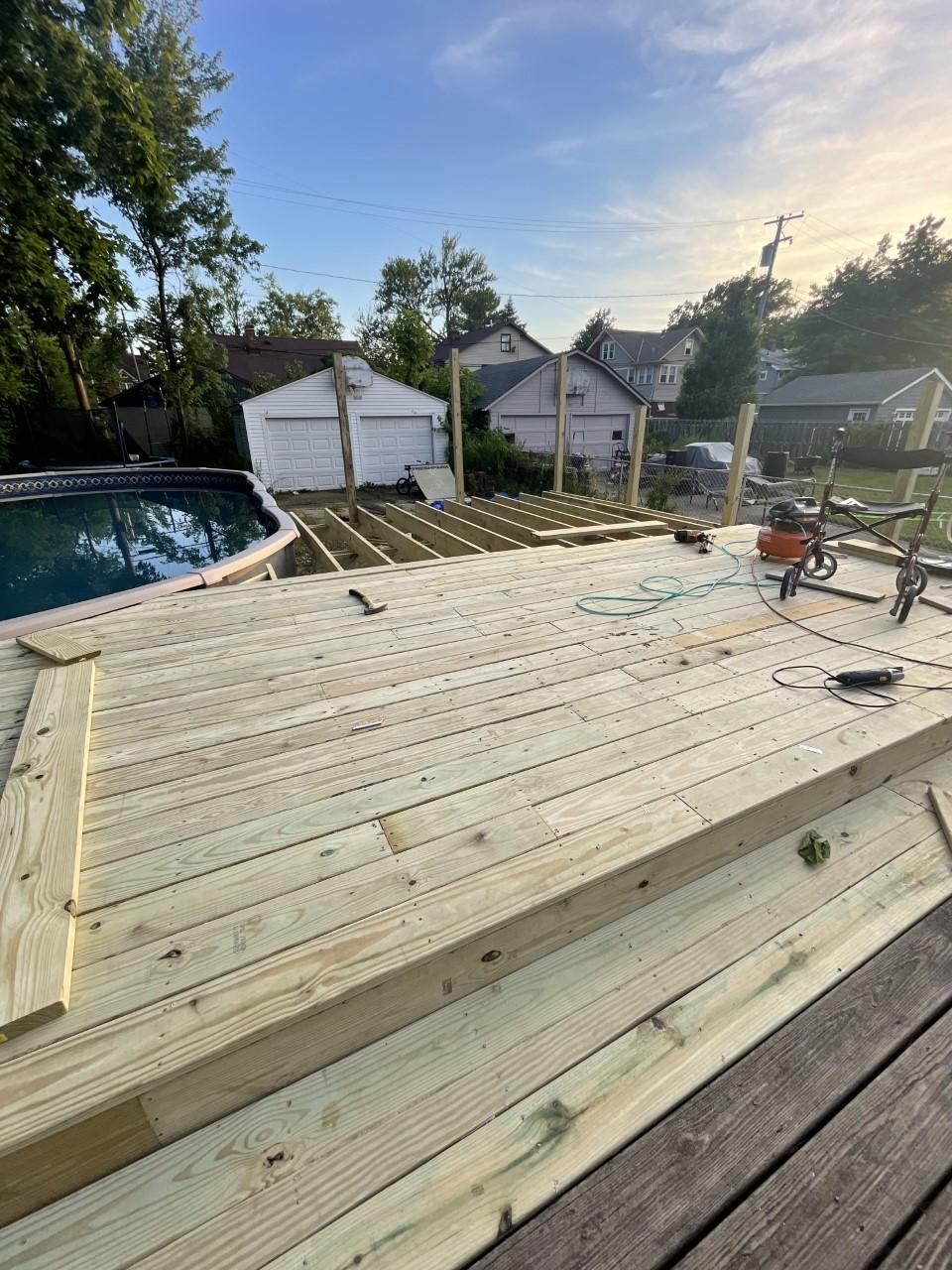
Signs It’s Time to Re-Stain Your Deck
If your deck looks faded, feels rough, or no longer repels water — it’s time to re-stain. Regular staining protects your deck from moisture, sun damage, and rot. Ignoring the signs can lead to costly repairs down the road.
Signs It’s Time to Re-Stain Your Deck
You might not notice it right away, but your deck quietly takes a beating all year — from blazing sun to heavy rain, snow piles, and foot traffic. Over time, even the best-looking stain starts to wear thin. And if you’re wondering whether it’s time to re-stain your deck, you’re not alone — this is one of the most common questions we get from homeowners across Northeast Ohio.
Here’s how to tell when your deck needs attention, plus what to do about it.
🪵 1. The Wood Looks Faded or Washed Out
One of the easiest signs to spot: the rich color of your deck has dulled or disappeared. Whether you used a semi-transparent stain or a solid one, UV rays eventually break it down.
What to look for:
- Graying or bleaching of the wood surface
- Patchy color or uneven tones
- A “dry” look, especially in full sun areas
🎯 Expert Tip: Most deck stains fade after 2–4 years depending on sun exposure. If your deck faces west or south, you may need to re-stain more frequently.
💧 2. Water No Longer Beads on the Surface
A properly sealed deck will cause water to bead up and roll off — just like a freshly waxed car. When that stops happening, your stain is no longer doing its job.
Try this:
Sprinkle a few drops of water on the deck boards. If the water:
- Beads up = stain is still working
- Soaks in = time to re-stain
This is especially important in Northeast Ohio’s wet seasons, where unsealed wood can rot quickly.
🪚 3. The Surface Feels Rough or Splinters Easily
When stain wears off, the wood underneath is exposed to the elements. Over time, this leads to dryness, cracking, and splinters — all signs your deck is unprotected.
Check the surface with your hand:
- Does it feel brittle, rough, or flaky?
- Are splinters coming up around nail heads or joints?
- Is the grain of the wood raised or fuzzy?
👷 Safety First: A rough deck isn’t just an eyesore — it’s a hazard for bare feet, pets, and kids. Re-staining can smooth it out and add a protective seal.
🧽 4. Mold, Mildew, or Algae Are Spreading
Stain isn’t just about color — it acts as a barrier against moisture and organic growth. If your deck is growing green, black, or white spots, that’s a red flag.
You might notice:
- Black mildew in shady corners
- Green algae where water pools
- White fuzz or film on the surface
Even pressure-treated wood can rot if moisture is allowed to soak in. Mold and algae mean the seal is compromised.
🧼 Clean First, Then Stain: Always clean and let the deck dry fully before applying fresh stain.
⚙️ 5. Flaking or Peeling Stain
If your last stain was applied too thick, or wasn’t properly absorbed into the wood, it may peel, chip, or bubble. This is more common with solid stains or poorly prepped surfaces.
What this means:
- Your deck needs to be stripped or sanded before re-staining
- The old stain is no longer protecting the wood
- Moisture is likely trapped under flaking layers
This is one of the top issues we get called in to fix — especially on DIY jobs where prep was skipped or improper stain was used.
📅 6. It’s Been Over 3 Years Since Your Last Stain
Even if your deck “looks okay,” the protection may be gone. Most decks need re-staining every 2–3 years — sooner in high-traffic, full-sun, or wet areas.
Timeline Guidelines:
- Semi-transparent stains: 2–3 years
- Solid stains: 3–5 years
- Clear sealers: 1–2 years
📍 Northeast Ohio Note: Freeze-thaw cycles, lake-effect snow, and humidity accelerate wear — don’t push your luck too far past that 3-year mark.
🧰 What to Do If You Notice These Signs
If you’ve spotted one or more of the signs above, your deck is ready for fresh stain. Here’s the general process:
- Inspect the wood for damage (replace boards if needed)
- Clean the surface thoroughly (deck cleaner or power wash)
- Let it dry fully (24–72 hours depending on humidity)
- Choose the right stain for your wood and weather exposure
- Apply the stain using brush, roller, or sprayer
- Let it cure fully before moving furniture or walking barefoot
If that sounds like a lot, don’t worry — it is. That’s where we come in.
💼 Let Us Handle It for You
At Colin Can Help, we specialize in deck and porch staining that lasts. Our full-service approach includes:
- Free inspections and honest assessments
- Product selection tailored to your goals
- Surface prep, board repairs, and stain application
- Ongoing maintenance reminders so you never miss a season
👍 We make it easy: You relax, we restore your deck.
🧠 FAQ
Q: Can I just reapply stain without sanding or cleaning first?
No — stain won’t adhere to dirty or weathered wood. You’ll need to clean at minimum, and in many cases, sanding is required.
Q: What if I just want to touch up faded areas?
Spot-touching can work temporarily, but the color often won’t match exactly. A full re-coat gives the most even, lasting results.
Q: How long after rain can I stain?
Wait at least 24–48 hours after rain. Moisture in the wood will prevent stain from absorbing properly.
Q: Is it better to stain in spring or fall?
Both are great — as long as temps are mild (50–80°F) and no rain is forecast for 2–3 days. We cover timing more in this guide.
Q: Will stain stop wood from rotting?
Yes — when properly applied, stain repels water and blocks UV damage, which are the top causes of rot in deck wood.




No Comments
Sorry, the comment form is closed at this time.